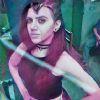|
Because the vfx team let the effects evolve on set without changing the director's documentary style, in Twilight the goal was to get as many effects as possible in-camera. All images Summit Ent. LLC. Courtesy of CIS Vancouver. |
The teen-lit phenom
Twilight has blazed its way to the screen with an opening box office bow of $69.6 million, courtesy of director Catherine Hardwicke (
Thirteen) and Summit Ent. Based on the first of author Stephanie Meyer's quartet of books about a teenage vampire in love (which has sold a reported 17 million copies),
Twilight has a large audience with built-in expectations about how it should unfold. And that applies to the visual effects as well as the love story between vampire Edward (Robert Pattinson) and his girlfriend Bella (Kristen Stewart). Because in
Twilight, the vampires possess special abilities that have to be visualized -- they can race through treetops and hurl objects at impossible speeds. And when their skin is exposed to sunlight, they appear to sparkle with a thousand diamonds.
Visual Effects Supervisor
Richard Kidd recalls, "When I first came on the show, there were about 350 vfx shots planned. We thought that would grow to 500, but between early pre-production and when we actually started to shoot, we went down to about 95 shots. Of course, we knew it would grow back up again." Kidd, whose extensive credits include
Armageddon,
The Mummy,
Transformers,
Spider-Man 3,
Hancock,
Cast Away and
The Chronicles of Narnia: The Lion, the Witch & the Wardrobe, knew it was crucial to home in on the absolutely essential effects that reveal the vampires' powers. "There are only a certain percentage of shots you can do if you don't prepare."
"The director's focus was on the acting and the story," notes Kidd. "Catherine has a very documentary style -- sort of run and gun, which doesn't lend itself to visual effects. So my job in pre-pro and on set was to give her what she needed without changing her style. We just had to let it evolve. But at the same time, the idea was to plan in such a way that we could minimize the amount of visual effects shots. The whole process was to let them shoot this in such a way that we didn't end up with 500."
One strategy that made this possible was the pre-pro testing that Kidd conducted in L.A. before principal shooting began in Portland, Oregon. Kidd's goal was to try and get as many effects as possible in-camera. "So we actually shot for a number of days with a stunt unit on an exterior location near Lake Sherwood. Second Unit Director Andy Cheng and Second Unit DP Patrick Loungway and I tried a number of different techniques to make the vampires appear to run really fast and fly through the trees really quickly. We'd come up with some ideas, but we didn't know how well the stunt guys would be able to do them. One of those was what we called the 'magic carpet,' where we strung 15 pieces of 8-foot plexiglass that were pulled by a truck going 30mph. It was basically like an airport conveyor belt being pulled by a truck. So the stunt people would run on a surface that was also moving. But it's right near the ground so we could hide it as much as possible."
This had the effect of making the background trees appear to rush by especially fast, which sold the idea of the vampires' hyper-speed abilities. Kidd's team also experimented with variable film camera speeds to achieve different looks. "We figured out that a number of those techniques would work. We also shot tests with the Phantom HD camera, but we found that it wouldn't be usable in production for all the shots we needed."
All of Kidd's planning paid off during post for the digital visual effects team at CIS Vancouver, the main vendor on
Twilight. "Richard was our man on the ground," says CIS Digital Effects Supervisor Geoffrey Hancock, a veteran supervisor whose credits include
The Changeling,
Vantage Point,
Night at the Museum and
I, Robot. "We'd had talks early on about things that we wanted to avoid, like moving branches. But Richard was able to get us all the information we needed."
Kidd recalls that while shooting the actors and stunt doubles on wires in the trees he tried to minimize anything that would present particularly difficult rotoscoping problems for the CIS team. "One of the things we came up against was that if we were moving the camera a lot we'd end up with trees behind trees multi-planing against each other -- and we'd also have a bunch of wires in the middle of that." Once those wires were removed, he notes, "CIS would have to replace infinitesimally small leaves. That made for some challenging rotos, but we tried to minimize that as much as possible while we were shooting so they didn't have very horrendous rotos."
In one signature shot of the protagonists in the trees, Kidd explains, "The stunt doubles were 100-plus feet up in a tree as we swoop around them and pull back. We needed to add a lot more trees to make the shot work. We didn't have the ability to turn this into a $100,000 shot by adding 3D-CG trees. And we weren't able to provide CIS with photographic elements of 100-foot-tall trees because we didn't have a helicopter to shoot elements. So, CIS came up with a way of creating 2D trees on cards that was cost-effective and also visually uncompromising."






comment:
p_commentcount